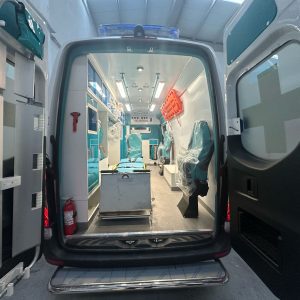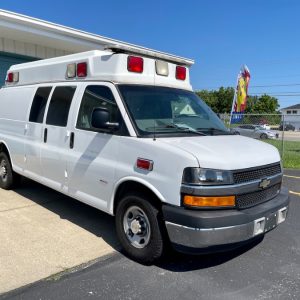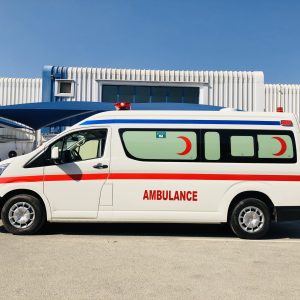1. Introduction
Mercedes Sprinter 417 CDI Ambulance; is the embodiment of the modern, highly technological ambulance. Minivans are becoming increasingly popular in medical practice. They are presented in a great variety of models from domestic and foreign manufacturers. The paper deals with the minibus Mercedes Sprinter (Fig. 1). Its significant advantage is that it is the only van in its class in which it is possible to place 2 rows of patients opposite each other with stretchers or beds along the emergency call of the patient compartment width. The high height of the emergency call and convenient access inside favor the safety and convenience of work with patients, and provide the necessary volume of the compartment, so that it can comfortably accommodate 2 nurses at the same time.
In March 2015, on the basis of the tubular frame, cabin, and undercarriage of the Mercedes Sprinter 417 CDI minibus, the Azavtoflotgermainistik FL plant at the Ordenburg automobile plant was modernized and constructed a patient compartment of a new model sanitary adjustable vehicle of small capacity. The minibus is equipped with a diesel engine producing 170 hp. In view of the fact that there were no basic requirements to improve upon the established types of Sanitary Adjustable Vehicles of Small Capacity, driven by an eye to the trend of increasing demand for this type of vehicle, the customer entrusted the plant with the task of developing a fundamentally new and unique car, unprecedented in the CIS and Russia, with expanded functionality, a high level of passive safety, and driver comfort. The infinitely variable roof line from 2050 up to 2100 mm allowed to equip the compartment with a ventilation conditioner, to provide floodlight illumination, to ensure the removal of air from the compartment, to use the compartment as part of the circuit for crash tests and the FIA homologation, which is extremely important for the subsequent operation of the Formula 1 in the status of a medical delegate.
2. Key Design Considerations Mercedes Sprinter 417 CDI Ambulance
The subject of this review was prompted by the desire of our team to explore the specialized features of the Mercedes Sprinter 417 CDI patient compartment. This ambulance modification was delivered to our titanium sponsor 12 years ago. During this time, the car has undergone many modifications, most of which were not found in the serial version of the car. The existing publications have a theoretical and practical coordination of the parameters and criteria for the design and transport of the patient compartment. In the patient compartment, most of the actions are performed to save the patient’s life and health. By adjusting the design of the compartment, the conditions inside it are created with the required parameters.
The need for this study is due to the current problems associated with the use of ambulances belonging to the FDA, the method of transportation of victims, and the method of accompanying rescuers in them, the need to create a unified and standardized process for the use of vehicles entrusted to the FDX. As methods of analyzing the parameters of the compartment, methods of study of anthropometric parameters of motor activity of the patient and medical personnel are used, methods for assessing the energy parameters of the electroencephalogram and quantitative parameters of light, as well as methods for analyzing data from clinical studies of patients. The results of this study confirm that various methods are applied during the development of the project (ergonomic forecasting by the user, ergonomic prediction by the user, functional forecasting, parametric forecast). The recommendations given can be implemented on 4D printers at the stage of sketch design and in the development of design documentation.
2.1. Safety and Ergonomics
In the section “Safety and Ergonomics,” the main safety-related requirements and rules, as well as the specialized ambulance equipment providing a secure environment for the medical team and the transported patients, are described. The design and proportion-related requirements, together with the specialized safety equipment (the anti-torsion bars, lashing rails with load-securing equipment) provided for the secure transportation and fastening of medical equipment and patient’s basket stretcher on the vehicle’s floor, are a part of the mentioned considerations. The design requirements have become effective as a part of the recognized voluntary standard EN 1789 which is widely used in the European Union member states and beyond.
The safety features of the PMV (Protected rescue module) for the patient’s transportation on the ambulance vehicle’s chassis are designed regarding the known passive and active safety requirements defined for large and big-size trucks, as well as for the urban buses. While ensuring the basic level of vehicle’s passive safety in the minimal setup, by adding the appropriate safety systems, the extra level of the patient’s secure transportation can be reached. The same principles are applied to obtain the required levels of PMVs intended for the protection and the transport of wounded patients in a combat situation and natural disasters, as well as for the PMVs designed for the transportation of the patients who suffered from the pandemic infectious disease.
2.2. Accessibility and Mobility Mercedes Sprinter 417 CDI Ambulance
One of the most crucial elements to be designed in VLIU is the one providing, managing and fitting accessibility and mobility of the crew and the patient(s). In that respect, handrails, anti-skid flooring, integral grip handles for the medical staff, cabinets and internal shapes are focusing on that. Apart from the localized standardized handrails, the well-known practice of handrails fixed on the roof has been used, in order to allow vertical standing and hence, free hands for the medical staff. Account for moving with a wheelchair will demand a different design thereof. A quite distinct matter is also the location and number of seats, in order for the staff to rest, be resolute for the carries to do first aid to crew members and for being firmly positioned while the action ambulances are moving very fast.
3. Medical Equipment Integration Mercedes Sprinter 417 CDI Ambulance
This step of the project encompassed the positioning and integration of all the medical equipment, furniture, and necessary technical ambiance in the patient compartment. The used equipment consists mostly of systems compliant with legal norms and requirements in the field, vehicles pre-tested ambulance functioning systems, and the new equipment presented in this paper. This specialty of the compartment confined the volumes of numerous functional objects, restricted the available space for their integration. In some particular cases, the number of equipment or the quantity of operated items was determined by structural constraints.
Although vast, the integrated equipment systems were constructed to respond to common specific tasks and environmental conditions and grouped according to the importance level that their respective activities assume as protection needs or support of the patient treatment. For the steering of the compartment’s integration, Mercedes Sprinter 417 CDI Ambulance; the automotive norm EN 1789 was used as a guide. Moreover, because the spatial constraints considerably influenced the ergonomic layout of the compartment, a parametric spatial mathematical model was developed in Excel to facilitate the evaluation of the placement and the physical compatibility constraints accomplishment of the systems. A particular study was performed for the pre-hospital ultrasound examination system (TAS), tested in the patient’s interior in order to improve the imaging diagnostic process with minimal medical diagnostic procedures. A 30° diagonal, individual collapsible patient seat, safestat disorders monitoring sensors, a remote monitoring system with user-defined expert observation-assistance algorithms, and induction-charging powered/hot-swap integrated electro-mechanical devices were other new features also developed and integrated in the patient’s compartment.
4. Advanced Technological Features
Central Panel: The central panel of MMC exhibits all technological systems in the PCI. Centrally, in the main unit, there are a radio transceiver, foam unit, main switch, and IP phone. The monitor of the multi-display camera system, centralized system control, chrome panel for system status alarms equipped with acoustic and visual indicators, and MP3 player-based radio units were installed in the mid-panel displaying the front panel. The console unit, which extends to the front base-front end main system control, includes a reversing camera, multi-channel digital audio, and a world-band radio. (Special Design)
Wireless Hotspot: Wireless access is provided through a Wi-Fi internet service to be provided by the vehicle. A Wi-Fi hotspot has been created for the passengers and for work to be done on the ambulance patient while the patient is on the way. (Special Design)
Technological Medipod: In the ambulance compartment, there are hot and cold distilled water units, needle bins, glove containers, infusion stand units, and an x-ray-lithotriptic medical device within the Technological Medipod feature in their technological base. The Canmar castor minder, which has come to the end of its life system, was newly designed and made. (Special Design)
Fully Electronic Lockable Medicine Cabinet: A central electric drawer system (cast iron type), central hatch, and central connected refrigerator have been specified in the vehicle in the technology operating chamber. In the same place, there is a clothes hanger, a litter top work telephone, and a TV system. (Special Design)
5. Case Studies and Real-World Applications Mercedes Sprinter 417 CDI Ambulance
This section describes several implementations of web-based augmented reality applications from academic settings, such as museum exhibits and university and primary school teaching applications. From the commercial sector, we present examples of prototype, trial, and released software, covering automotive care manuals, entertainment and leisure, tourism, and news and information applications. These demonstrate that web-based augmented reality is a maturing technology that has a range of potential uses on both the global web and organizational intranets.
An ambulance is the most important component in the system of medical care, and the patient compartment is a place where doctors take care of the patient. Because of the special operating environment, the ambulance has some specialized features distinct from ordinary passenger cars, and the design of the patient compartment is directly related to whether the patient could survive on the way to the hospital. This paper presents a specialized design regarding the patient compartment of an ambulance based on the Mercedes-Benz Sprinter 417 CDI, which is used by the Emergency Medical Service Station in Shanghai. Detailed design steps, specialized function solutions, and installation advice dedicated to the patient compartment will be further elaborated, including the medical equipment cabinet, the central console, drug delivery drawer, medical waste storage cabinet, negative pressure oxygen supply system, camera system, intercom system, and so on. This creation would be able to afford some guidance for relevant institutions.













